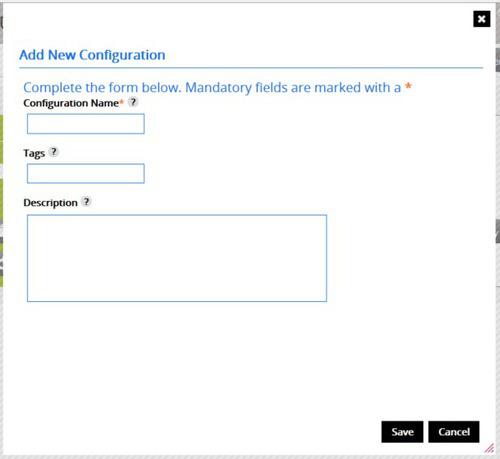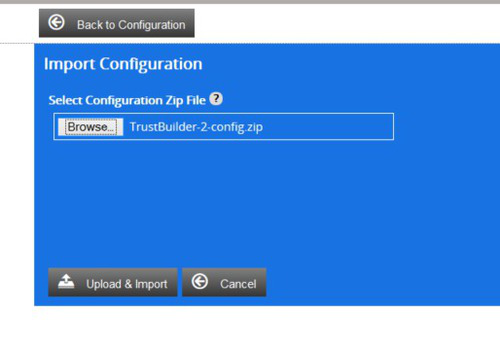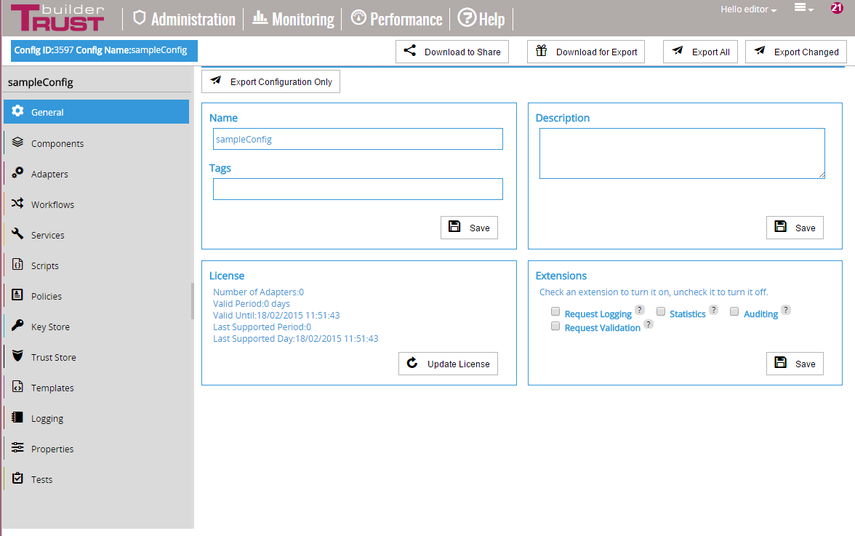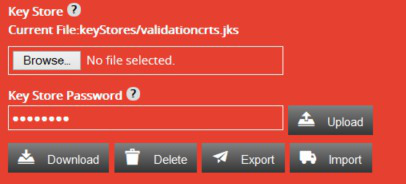Working with Configuration
A TB.Connect Configuration (TB Config) is the collection of resources that TB.Connect uses to function. These include the following:
Resource Type | Description | Required |
|---|---|---|
Configuration file | Here adapters, workflow references, license, security keys and services are defined. | Yes. |
Workflow file | The workflow performed by TB.Connect against an incoming request | Yes at least one. |
Script files | Scripts that are used by the workflow | No |
Template files | Templates, such as login page, that are used by the scripts to render pages | No |
Layout files | These are TB.Connect representations of workflow files | One for each workflow |
Workflow Test Files | These are Javascript files used to test workflows | No |
Logging | This is the logging configuration for TB.Connect | No |
Properties files | TB.Connect can be configured using a .properties file | No |
All of these items can be created/imported and edited within TB.Connect.
Adding a New TB.Connect Configuration
Form Field | Description | Is Required? |
|---|---|---|
Configuration Name | An identifier for the configuration | yes |
Tags | This is a comma delimited list of tags that can be used to filter the view of TB Servers. | no |
Description | A description of the TB Server, used only by TB.Connect. | no |

Once the form is saved a new unrelated configuration is created.
This configuration has an expired license no adapter, workflows, scripts, templates or services.

Import a New TB.Connect Configuration
To import a TB.Connect Configuration from an already established TB Server first create a TB Server pointing to the correct host and management port.
Then click the Options button on the TB Server box, and then import.
A new configuration will then be created and all the files found in TB_HOME of the server will be imported. The configuration will be automatically related to the TB Server that imported it.
Upload a New TB.Connect Configuration
Configurations can be packaged and zipped from the TrustBuilder Administrator (TB.Connect). Naturally the application offers the option to upload and import packaged configurations also. This function will only accept configurations that are packaged by TB.Connect for 100% compatibility package and upload using the same versions of TB.Connect. This is a secure way of sharing configurations if network restrictions apply.
To upload a packaged config click the Upload Config Zip button.

On the next screen select the configuration zip file from you local computer.

Then click the Upload & Import button. You will then be taken to the configuration editing screen with everything imported. A new unrelated configuration block is created on the Server screen named ID-uploadedConfig
Enabling Export for a Configuration
In order to export a configuration it must first be related to one or more TB Servers. To do this drag and drop a configuration box onto a TB Server box.
The TB Server box will then be coloured green and hold the id and name of the configuration that it is now related to. The configuration box will be coloured blue.
To see which TB Servers are related to a specific configuration move the mouse over the configuration box and the related TB Servers will be coloured blue.
The same applies if the mouse is moved over the name of a configuration within a TB Server box, the relevant configuration is then coloured green.
To break the relationship between a configuration and TB Sever click the rubbish bin icon on within the TB Server box to the right of the configuration name.
Once a configuration is related to at least one TB Server export buttons are displayed when editing the configuration.
Exporting Configuration from Server Screen
Once a configuration is related to one or more TB servers on the server screen then it can be exported. An export button will show on the configuration block. Click this button to export to all the servers that this configuration is related to. The standard export form will be displayed.
Exporting Configuration Whilst Editing
The complete configuration can also be exported during editing by clicking the Export All button at the top right of the configuration edit screen.
Downloading Configuration
A configuration can be downloaded from the configuration editing screen. This will produce a zip package containing the complete configuration. This zip package can be used on the Servers screen to import into another TB.Connect installation or distributed to a TB_HOME manually.
Deleting a Configuration
To delete a configuration click the delete button within the configuration box. This action is not reversible there is no undo.
When a configuration all of it's relationships with TB Servers are broken. Those TB Servers are then left unrelated.
Editing a Configuration
To edit a configuration click the Edit button in the configuration box. This opens the configuration screen.

Configuration Tab
Overview
On the first tab of the configuration screen are general details directly related to the configuration.
Configuration Tags
This is the same as the tags entry on the Config & Servers screen and is only used within TB.Connect.
Description
This is the same as the description that can be entered from the Config & Servers screen and is only used within TB.Connect.
License
This is TB.Connect license. If this is a newly created configuration it will be an expired license.
To enter a new license click the Update button within the license box.

A form will then be displayed to past a new license key into.
Click the Save button to update the license or cancel.

Extensions
These enable or disable extra functionality of TB.Connect. Each extension is described by moving the mouse over the question mark icons to the right of each label.
Security
The security element of the configuration is for storage of any certificates that may be called by adapters or from scripts.
Two stores can be configured; a key store and a trust store. Both are secured by a password that is automatically encrypted.
From a security point of view, it is recommended to make a clear distinction between a trust store and a key store:
A trust store only contains public certificates making it ideal to share with other people.
A key store does contain private keys, which must be kept private.
Both stores must be of the same protocol and format.
The key store is used as trust store if no trust store has been defined.
More details of each input field can be viewed by mousing over the question marks beside each label
The TrustBuilder Administrator does not currently provide any interface to these key stores.
There are many 3rd party tools available that already fulfil this task such as:
Portecle ( http://portecle.sourceforge.net/ )
Keytool ( http://docs.oracle.com/javase/6/docs/technotes/tools/solaris/keytool.html )
Openssl
CERTivity Keystores Manager ( http://www.edulib.com/products/keystores-manager/overview/ )
Stores are uploaded from the local computer to the configuration in TB.Connect. To upload a store:
select a jks or p12 file
provide the password for that store.
click upload

Once the store is uploaded more buttons are displayed:
Download Store
Offers the functionality to download the store that TB.Connect has for this configuration
Delete
Delete the store from TB.Connect.
Export
Export the store to the servers that this configuration is related to. This button will only be displayed if this configuration is related to one or more servers. The store is also exported if the Export Complete Configuration is also used.
Import
This will import a store from a remote TrustBuilder Server. This will overwrite and store that is in TB.Connect.

The Save button will only save any changes made to the Key Store Password or Trust Store Password fields.
